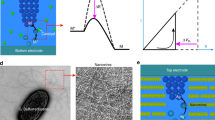Abstract
We report here on a new insight for bio-sensing based on the memristive effect of functionalized Schottky-barrier memristive silicon nanowire in dry environment. The device concept is discussed. Electrical measurements confirm the bio-detection by the narrowing of the memristive I ds − V ds hysteresis upon interaction of antigen with antibody-functionalized nanowire.
Similar content being viewed by others
Avoid common mistakes on your manuscript.
1 Introduction
Recently, there has been an increasing interest in nano-bio-sensing applications, due to possibility for minimal invasive, real-time monitoring for preventive treatments and therapy personalization [1]. In particular, one-dimensional silicon nanowires are good candidates for sensing devices due to their very large surface-to-volume ratio and quantum properties [2]. However, the sensing with nanowires is only exploited by the ion-sensitive field-effect-transistor paradigm [3]. Due to the nano-scale of the fabricated geometries [4], the recent discovery in solid-state devices of the memristive effect has been source of renewed research efforts in applications for high-density memory device [5]. The physical phenomena governing the memristive behavior are attributed to the change of an internal state variable, which modifies the conductance in a non-volatile manner [6]. As reported by Duan et al., memory devices are possible also with molecule-gated nanowire transistors by using redox active molecules [7]. In this short communication, we report the first evidence of unexpected new insights for a novel molecular sensing in dry conditions based on nanofabricated memristors functionalized with bio-molecular thin films. In Section 2, we describe the nano-fabrication of memristive Schottky-barrier silicon nanowires.
2 Device Nano-fabrication
The fabrication method utilizes some of the steps that were previously reported [8] for memristive Schottky-barrier silicon nanowire field-effect transistors. The process starts from low resistivity silicon-on-insulator substrates, with 1.5 μm device layer and 3 μm SiO2 insulating layer. After standard lithography, the silicon nanowire is carved anchored at the top of two silicon pillars. Then, Ni is deposited on top of the pillars with overlap on the outer portions of the silicon nanowire. Hence, an annealing step at 450°C in a horizontal wall furnace forms NiSi contacts. Figure 1 shows a nano-fabricated memristive silicon nanowire with NiSi contacts.
4 Results and Discussion
Electrical measurements are carried out in a shielded probe station connected with HP4156C Semiconductor Parameter Analyzer and in dark, to avoid any photo-generated currents. Before functionalization with the AB layer, I ds − V ds curves taken for forward and backward sweep do show a typical memristive behavior (see Fig. 2a), where the current minima always occur for V ds = 0 V, consistently with previously reported measurements [8] on non-functionalized devices. Conversely, functionalized silicon nanowires show different positions of the current minima for backward or forward regimes. This effect is observed after drying from (a) de-ionized H2O solution and (b) 5 pM AG solution. The I ds − V ds curve before AG up-take shows an hysteresis (curve 1 in Fig. 2b) due to charge trapping mechanisms at the Schottky junctions. The binding of an AG with the functionalized wire is responsible for a modification of the hysteresis (curve 2 in Fig. 2b), in particular to a reduction of the current minimum gap between forward and backward V ds sweeps. Coherently, the up-take of increasing amounts of AG (in the pM range) results on a further diminishing of this gap.
Ids − Vds curves: a before functionalization with AB bio-layer. A typical memristive hysteresis is observed, with no ΔVds gap between Ids minima in forward and backward regimes; b the blue curve (1) is measured after drying the sample from de-ionized water. The red curve (2) is measured after dipping in 5 pM AG solution and drying
5 Conclusions
We have demonstrated a new type of bio-sensing method, which is based on the memristive effect in Schottky-barrier silicon nanowires. This completely novel memristive detection principle is able to sense low concentrations of bio-molecules, due to interactions occurring at the nanoscale between the molecular charges trapped by the bio-layer at the surface of the wire and the ambipolar carriers supporting the memristive conductivity into the wire.
References
Carrara, S. (Ed.) (2010). Nano-bio-sensing. New York: Springer. ISBN 978-1-4419-6168-6.
Patolsky, F., Zheng, G., Lieber, C. M. (2006). Nature Protocols, 1(4), 1711.
Zheng, G., Patolsky, F., Cui, Y., Wang, W., Lieber, C. (2005). Nature Biotechnology, 23(10), 1294.
Strukov, D. B., Snider, G. S., Stewart, D. R., Williams, R. S. (2008). Nature, 453, 80.
Jo, S. H., Kim, K. H., Lu, W. (2009). Nano Letters, 9(2), 870.
Chua, L., & Kang, S. M. (1976). Proceedings of the IEEE, 64(2), 209.
Duan, X., Huang, Y., Lieber, C. M. (2002). Nano Letters, 2(5), 487.
Sacchetto, D., Ben-Jamaa, M., Carrara, S., De Micheli, G., Leblebici, Y. (2010). In Circuits and systems (ISCAS) (pp. 9–12).
Kim, D., Lee, H. G., Jung, H., Kang, S. H. (2007). Bulletin of The Korean Chemical Society, 28(5), 783.
Kusnezow, W., Jacob, A., Walijew, A., Diehl, F., Hoheisel, J. (2003). Proteomics, 3(3), 254.
Acknowledgements
The authors would like to acknowledge Pietro Delmastro and Ioannis Xenarios for assistance in the fabrication and stimulating discussion, respectively. This work has been partially supported by the Swiss NSF grant no. 200021-122168, Swiss NSF grant no. 200021-132539, Nano-Tera grant no. 20NA21-128841 and Nano-Tera grant no. 20NA21-128840.
Author information
Authors and Affiliations
Corresponding author
Rights and permissions
About this article
Cite this article
Sacchetto, D., Doucey, MA., De Micheli, G. et al. New Insight on Bio-sensing by Nano-fabricated Memristors. BioNanoSci. 1, 1–3 (2011). https://doi.org/10.1007/s12668-011-0002-9
Published:
Issue Date:
DOI: https://doi.org/10.1007/s12668-011-0002-9






